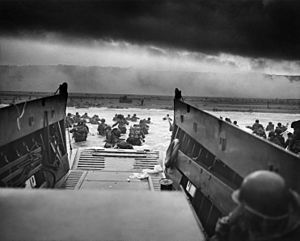Omaha Beach facts for kids
Quick facts for kids Omaha |
|||||||
|---|---|---|---|---|---|---|---|
| Part of the Normandy landings, World War II | |||||||
 Into the Jaws of Death: Troops from the U.S. 1st Infantry Division landing on Omaha, as photographed by Robert F. Sargent |
|||||||
|
|||||||
| Belligerents | |||||||
| Commanders and leaders | |||||||
| Units involved | |||||||
|
|
||||||
| Strength | |||||||
| 43,250 infantry 2 battleships 3 cruisers 13 destroyers 1,010 other vessels |
7,800 infantry 8 artillery bunkers 35 pillboxes 4 artillery pieces 6 mortar pits 18 anti-tank guns 45 rocket launcher sites 85 machine gun sites 6 tank turrets |
||||||
| Casualties and losses | |||||||
| 2,000–5,000+ | 1,200 | ||||||
Omaha Beach was the code name for one of the five main landing areas during the Normandy landings on June 6, 1944. This huge invasion was a key part of World War II. Omaha Beach is a 5-mile (8 km) stretch of coastline in Normandy, France. It faces the English Channel and is located between Sainte-Honorine-des-Pertes and Vierville-sur-Mer.
The goal of landing at Omaha was to connect the British forces landing at Gold to the east with the American forces at Utah to the west. This would create a continuous area for the Allies to control on the French coast.
American soldiers were in charge of the ground attack at Omaha. The United States Navy and United States Coast Guard provided most of the sea transport, cleared mines, and bombarded the German defenses from ships. The British, Canadian, and Free French navies also helped.
Contents
What Was the Main Goal at Omaha Beach?
The main goal at Omaha Beach was to secure a safe landing area, or beachhead, about 8 miles (13 km) deep. This area was meant to stretch between Port-en-Bessin and the Vire River. It would link up with the British landings at Gold Beach to the east. To the west, the plan was to reach Isigny and connect with another American force, the VII Corps, landing at Utah Beach.
Who Fought at Omaha Beach?
The American forces were divided into two main groups for the assault. The 29th Infantry Division, which had not seen much combat, attacked the western part of the beach. They were joined by nine companies of U.S. Army Rangers. These Rangers were originally supposed to attack Pointe du Hoc but were redirected to Omaha. The 1st Infantry Division, which was very experienced in battle, took on the eastern half of Omaha Beach.
The German forces defending Omaha Beach were part of the 352nd Infantry Division. This division had 12,020 soldiers, with 6,800 of them being experienced fighters. They were spread out along a 33-mile (53 km) front. The German plan was to stop any invasion right at the water's edge. Their defenses included many strongpoints built along the coast.
How Was the Invasion Planned?
The Allied plan for Omaha Beach involved several waves of attack. First, tanks, infantry (foot soldiers), and combat engineers were supposed to land. Their job was to destroy the German defenses along the coast. After these initial forces cleared the way, larger ships would be able to land more troops and equipment.
What Went Wrong with the Plan?
Unfortunately, very little went according to plan on D-Day at Omaha Beach.
- Navigation Problems: Many landing craft missed their intended landing spots because of difficulties with navigation. This meant troops landed in the wrong places throughout the day.
- Strong Defenses: The German defenses were much stronger than the Allies expected. They caused heavy losses among the American troops as they tried to land.
- Obstacles on the Beach: Under intense enemy fire, the engineers struggled to clear the many obstacles the Germans had placed on the beach. These obstacles included mines and barriers designed to stop landing craft.
- Troops Piling Up: Because only a few paths were cleared through the obstacles, later waves of landings became crowded in those small areas. This made them easy targets for German defenders.
- Difficulty Moving Inland: The American assault troops were weakened by the many casualties they took just getting onto the beach. This made it very hard for them to break through the heavily defended exits that led off the beach and further inland. These delays caused even more problems for later landings.
How Did the Allies Finally Succeed?
Despite all the difficulties, small groups of surviving soldiers managed to push forward. They made their own attacks, climbing the steep cliffs between the strongest German defense points. By the end of D-Day, the Allies had managed to gain two small, separate footholds on the beach.
In the days that followed, these small areas were expanded. The Allies pushed further inland against weaker German defenses. Eventually, they achieved the original goals set for D-Day at Omaha Beach.
Images for kids
-
2nd Infantry Division troops and equipment going up the bluff via the E-1 draw on D+1, June 7. They are going past WN-65 that defended the route up the Ruquet Valley to Saint-Laurent-sur-Mer.
See also
 In Spanish: Playa de Omaha para niños
In Spanish: Playa de Omaha para niños















